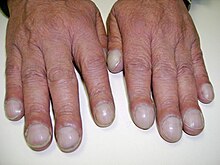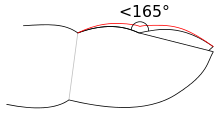Loading AI tools
Deformity of the finger or toe nails From Wikipedia, the free encyclopedia
Nail clubbing, also known as digital clubbing or clubbing, is a deformity of the finger or toe nails associated with a number of diseases, anomalies and defects, some congenital, mostly of the heart and lungs.[2][3] When it occurs together with joint effusions, joint pains, and abnormal skin and bone growth it is known as hypertrophic osteoarthropathy.[4]
| Clubbing | |
|---|---|
| Other names | Drumstick fingers/toes, Hippocratic fingers/toes, digital clubbing, watch-glass nails[1] |
 | |
| Clubbing | |
| Specialty | Pulmonology |
Clubbing is associated with lung cancer, lung infections, interstitial lung disease, cystic fibrosis, or cardiovascular disease.[5] Clubbing may also run in families,[5] and occur unassociated with other medical problems.[6][7]
Clubbing has been recognized as a sign of disease since the time of Hippocrates.[5]
Clubbing is associated with
Nail clubbing is not specific to chronic obstructive pulmonary disease (COPD). Therefore, in patients with COPD and significant degrees of clubbing, a search for signs of bronchogenic carcinoma (or other causes of clubbing) might still be indicated.[12] A congenital form has also been recognized.[13]

A special form of clubbing is hypertrophic pulmonary osteoarthropathy (HPOA), known in continental Europe as Pierre Marie-Bamberger syndrome. This is the combination of clubbing and thickening of periosteum (connective tissue lining of the bones) and synovium (lining of joints), and is often initially diagnosed as arthritis. It is commonly associated with lung cancer.[citation needed]
Primary hypertrophic osteoarthropathy is HPOA without signs of pulmonary disease. This form has a hereditary component, although subtle cardiac abnormalities can occasionally be found. It is known eponymously as the Touraine–Solente–Golé syndrome. This condition has been linked to mutations in the gene on the fourth chromosome (4q33-q34) coding for the enzyme 15-hydroxyprostaglandin dehydrogenase (HPGD); this leads to decreased breakdown of prostaglandin E2 and elevated levels of this substance.[14]
The exact cause for sporadic clubbing is unknown. Theories as to its cause include:


When clubbing is observed, pseudoclubbing should be excluded before making the diagnosis. Associated conditions may be identified by taking a detailed medical history—particular attention is paid to lung, heart, and gastrointestinal conditions—and conducting a thorough clinical examination, which may disclose associated features relevant to the underlying diagnosis. Additional studies such as a chest X-ray and a chest CT-scan may reveal otherwise asymptomatic cardiopulmonary disease.[12]
Clubbing is present in one of five stages:[12]
Schamroth's sign or Schamroth's window test (originally demonstrated by South African cardiologist Leo Schamroth on himself)[16] is a popular test for clubbing. When the distal phalanges (bones nearest the fingertips) of corresponding fingers of opposite hands are directly opposed (place fingernails of same finger on opposite hands against each other, nail to nail), a small diamond-shaped "window" is normally apparent between the nailbeds. If this window is obliterated, the test is positive and clubbing is present.
The exact frequency of clubbing in the population is not known. A 2008 study found clubbing in 1%, or 15 patients, of 1511 patients admitted to a department of internal medicine in Belgium. Of these, 40%, or 6 patients, turned out to have significant underlying disease of various causes, while 60%, or 9 patients, had no medical problems on further investigations and remained well over the subsequent year.[7]
At least since the time of Hippocrates, clubbing has been recognized as a sign of disease.[5] The phenomenon has been called "Hippocratic fingers".

The Dutch painter Dick Ket had nail clubbing as is seen from his paintings. He had an underlying disease, probably dextrocardia.[17]
Seamless Wikipedia browsing. On steroids.
Every time you click a link to Wikipedia, Wiktionary or Wikiquote in your browser's search results, it will show the modern Wikiwand interface.
Wikiwand extension is a five stars, simple, with minimum permission required to keep your browsing private, safe and transparent.